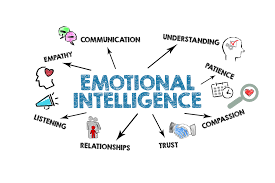The Impact of Emotional Intelligence on Rational and Ethical Decision-Making
##semicolon##
Emotional Intelligence##common.commaListSeparator## Decision-making##common.commaListSeparator## Self-Awareness##common.commaListSeparator## Self-Regulation##common.commaListSeparator## Empathy##common.commaListSeparator## Motivation##article.abstract##
Emotional intelligence (EI) plays a pivotal role in shaping effective decision-making in both personal and professional settings. This article explores how core components of EI—such as self-awareness, self-regulation, empathy, motivation, and social skills—directly influence the quality and outcomes of decisions. Traditional models of decision-making emphasize logic and analysis, but growing evidence suggests that emotional factors significantly impact choices, particularly in high-pressure or interpersonal contexts. Individuals with high emotional intelligence are better equipped to manage stress, recognize emotional triggers, and respond thoughtfully rather than react impulsively. They also demonstrate superior communication and collaboration skills, enabling them to make ethical and socially responsible decisions by considering the perspectives and feelings of others. The article presents real-world examples from leadership, crisis management, and organizational behavior to demonstrate how emotionally intelligent decision-makers drive positive results. In contrast, low EI can lead to biased judgment, conflict escalation, and poor emotional regulation. Furthermore, the article highlights the importance of developing EI through training, mindfulness, and feedback mechanisms. Enhancing emotional intelligence not only improves individual decision-making capacity but also fosters better teamwork and organizational health. By integrating emotional awareness with cognitive reasoning, decision-makers can achieve a more balanced and impactful approach to problem-solving. The findings advocate for the inclusion of EI development in educational curricula and leadership training programs to prepare individuals for complex, emotionally charged decision environments.
##plugins.themes.default.displayStats.downloads##
##submission.citations##
1. Brackett, M. A., Rivers, S. E., & Salovey, P. (2011). Emotional intelligence: Implications for personal, social, academic, and workplace success. Social and Personality Psychology Compass, 5(1), 88–103. https://doi.org/10.1111/j.1751-9004.2010.00334.x
2. Goleman, D. (1995). Emotional intelligence: Why it can matter more than IQ. Bantam Books.
3. Goleman, D. (1998). Working with emotional intelligence. Bantam Books.
4. Mayer, J. D., Caruso, D. R., & Salovey, P. (2016). The ability model of emotional intelligence: Principles and updates. Emotion Review, 8(4), 290–300. https://doi.org/10.1177/1754073916639667
5. Salovey, P., & Mayer, J. D. (1990). Emotional intelligence. Imagination, Cognition and Personality, 9(3), 185–211. https://doi.org/10.2190/DUGG-P24E-52WK-6CDG
6. Zeidner, M., Matthews, G., & Roberts, R. D. (2009). What we know about emotional intelligence: How it affects learning, work, relationships, and our mental health. MIT Press.
7. Damasio, A. R. (1994). Descartes' error: Emotion, reason, and the human brain. G.P. Putnam's Sons.
8. Goleman, D., Boyatzis, R., & McKee, A. (2013). Primal leadership: Unleashing the power of emotional intelligence. Harvard Business Review Press.
9. Lerner, J. S., Li, Y., Valdesolo, P., & Kassam, K. S. (2015). Emotion and decision making. Annual Review of Psychology, 66, 799–823. https://doi.org/10.1146/annurev-psych-010213-115043
10. Slovic, P., Finucane, M. L., Peters, E., & MacGregor, D. G. (2002). The affect heuristic. In T. Gilovich, D. Griffin, & D. Kahneman (Eds.), Heuristics and biases: The psychology of intuitive judgment (pp. 397–420). Cambridge University Press.
11. Goleman, D., Boyatzis, R., & McKee, A. (2013). Primal leadership: Unleashing the power of emotional intelligence. Harvard Business Review Press.
12. Mayer, J. D., Salovey, P., & Caruso, D. R. (2004). Emotional intelligence: Theory, findings, and implications. Psychological Inquiry, 15(3), 197–215. https://doi.org/10.1207/s15327965pli1503_02
13. Côté, S. (2014). Emotional intelligence in organizations. Annual Review of Organizational Psychology and Organizational Behavior, 1, 459–488. https://doi.org/10.1146/annurev-orgpsych-031413-091233
14. Fernández-Berrocal, P., & Extremera, N. (2006). Emotional intelligence: A theoretical and empirical review of its first 15 years of history. Psicothema, 18(Suppl), 7–12.
15. Lopes, P. N., Salovey, P., Côté, S., & Beers, M. (2004). Emotion regulation abilities and the quality of social interaction. Emotion, 5(1), 113–118. https://doi.org/10.1037/1528-3542.5.1.113
16. Rosete, D., & Ciarrochi, J. (2005). Emotional intelligence and its relationship to workplace performance outcomes of leadership effectiveness. Leadership & Organization Development Journal, 26(5), 388–399. https://doi.org/10.1108/01437730510607871
17. Humphrey, R. H. (2012). Effective leadership: Theory, cases, and applications. SAGE Publications.
18. Jordan, P. J., Ashkanasy, N. M., & Hartel, C. E. J. (2002). Emotional intelligence as a moderator of emotional and behavioral reactions to job insecurity. Academy of Management Review, 27(3), 361–372. https://doi.org/10.5465/amr.2002.7389900
19. Boyatzis, R. E., & McKee, A. (2005). Resonant leadership: Renewing yourself and connecting with others through mindfulness, hope, and compassion. Harvard Business School Press.
20. Brown, K. W., & Ryan, R. M. (2003). The benefits of being present: Mindfulness and its role in psychological well-being. Journal of Personality and Social Psychology, 84(4), 822–848. https://doi.org/10.1037/0022-3514.84.4.822

##submission.downloads##
##submissions.published##
##issue.issue##
##section.section##
##submission.license##
##submission.copyrightStatement##
##submission.license.cc.by-nc-nd4.footer##



